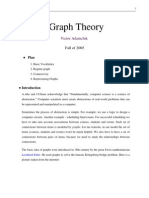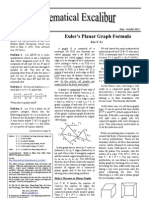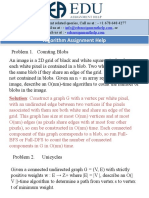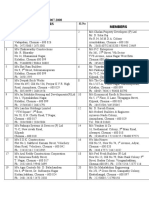Graphs 4 Print PDF
Graphs 4 Print PDF
Uploaded by
SuhailahOthmanCopyright:
Available Formats
Graphs 4 Print PDF
Graphs 4 Print PDF
Uploaded by
SuhailahOthmanOriginal Title
Copyright
Available Formats
Share this document
Did you find this document useful?
Is this content inappropriate?
Copyright:
Available Formats
Graphs 4 Print PDF
Graphs 4 Print PDF
Uploaded by
SuhailahOthmanCopyright:
Available Formats
1
V. Adamchik
Graph Theory
Victor Adamchik
Fall of 2005
Plan
1. The Chinese Postman Problem
2. The Traveling Salesman Problem
3. Graph Coloring
The Chinese Postman Problem
The Chinese Postman Problem (CPP) is a close cousin to finding an Euler cycle.
Given a connected weighted graph or digraph G the CPP is the problem of finding the
shortest cycle that uses each edge in G at least once. The name comes from the fact that a
Chinese mathematician, Mei-Ko Kwan (1962), developed the first algorithm to solve this
problem for a rural postman.
We will develop a method for solving this type of problem.
In the best situation, where each vertex has even degree, any Euler circuit solves the problem.
Consider a case when a graph has two vertices of odd degree.
V. Adamchik
21-127: Concepts of Mathematics
A
H
B
2
1
C
II
I
4
This picture immitates the mail delivery. A number assigned to an edge represents the time
needed to travel along the edge. Our job is to find a shortest route starting and ending at
vertex A.
The graph does not have an Euler cycle but an Euler path, because there are two vertices of
odd degrees. Therefore in order to cover all edges we will have to retrace edges IC and CF.
This will increrase the total time by 10.
3
A
H
B
2
1
C
II
I
4
The total time is 2
49
Is there faster route? Yes, we do not retrace CF, but rather use FE+ED+DC which is shorter
by 1.
V. Adamchik
Generally, it might be not so simple to find a shortest path between two vertices. In this
case we might use Dijkstra's algorithm (15-211).
What if the graph has more than two vertices of odd degree?
In this graph there are four vertices of odd degree B, D, F, H. If we connect two pairs of
these four vertices by two edges, the new graph will have an Euler cycle. It follows that we
need to find the two paths (connecting chosen pairs) with total weight as small as possible.
First we need to list all the ways to put the four odd vertices in two pairs.
Pairing
Path
Weight
Path
Weight
BD && FH
B-A-D
F-E-H
10
BF && DH
B-E-F
D-E-H
12
BH && DF
B-E-H
D-E-F
10
Then, for each set of two pairs we find the shortest path joining the two vertices in each of
the two pairs. Thje first pairing has the samllest total time 18. To find a specific route,
take the given graph and add the retraced streets as multiple edges. Then, find an Euler
circuit for this multigraph.
V. Adamchik
21-127: Concepts of Mathematics
The Traveling Salesman Problem
The Traveling Salesman Problem (TSP) is a close cousin to finding an Hamiltonian cycle.
Given a weighted graph G, you want to find the shortest cycle (may be non-simple) that
visits all the vertices.
Consider the following graph:
One cycle is a b c f e d a that has a total weight 26. Is there a shorter cycle?
The approximation algorithm. This algorithm does not solve the problem but rather yeilds a
solution which is within a factor of 2 of optimal (in the worst-case).
Here is the alghorithm
Step 1: find a MST.
Step 2: do a DFS of the MST.
V. Adamchik
Graph Coloring
Your mission color the entire map of South America.
1. No country may touch another country of the same color.
2. You will be charged each time you use a color
3. You must color the map as cheaply as possible.
We start with the graph representation: vertices represent countries. Two vertices are adjacent if two countries have a common boarder. So we reduce a problem to vertex coloring.
Adjacent vertices must be colored in different colors.
Definition. The chromatic number of a graph is the least number of colors required to do a
coloring of a graph.
V. Adamchik
21-127: Concepts of Mathematics
What is the largest possible chromatic number?
This question has puzzled mathaticians for a very long time. It has now been proved that
any planar graph will have a chromatic number of at most 4. This is called the Four Color
Problem. The problem was solved in 1976 by Appel and Heken. They developed an algorithm that solves the problem. The Four Colour Theorem is the first major theorem to be
proved using a computer, The disadvantage of this computer aid approach is that the proof
cannot be verified by hand.
Theorem
In any connected planar graph G (with at least 3 vertices), E
3V
6.
By means of this theorem we can prove that K5 is not planar. Indeed, K5 has 5 vertices and
10 edges. By the theorem 10
15
9 which is not true.
Proof.
a) If the graph has no cycles, E
E
V
E
1
V
V . Also, V
2V
3 or 2 V
E
3V
b) If the graph has a cycle. We will count the number of pairs (edge, face).
e1, F1 , e1, F2 , e2, F1 , e2, F2 , e3, F1 , e3, F2
V. Adamchik
On one hand, each face is bounded by at least 3 edges. So
edge, face
3F
On other hand, each edge is associated with at most two faces,
edge, face
2E
Combining these together, yeilds
3F
edge, face
2E
or
3F
2E
By the Euler formula
2
3V
3F
3E
3V
2E
3E
3V
QED
Corollary
V, E has a vertex of degree less than 6.
Every simple planar graph G
Proof.
Using the handshaking theorem combined with the previous theorem
deg v
v V
Find the average degree
3V
V. Adamchik
21-127: Concepts of Mathematics
1
V
deg v
6V
12
V
v V
12
V
So, at least one vertex has a degree less than 6.
QED
Theorem. (Six Color Theorem)
Any simple planar graph G can be colored with 6 colors.
Proof (by induction on number of vertices).
If G has six or less vertices, then the result is obvious.
Suppose that all such graphs with n
1 vertices are 6-colorable.
We have proved (see Corollary in the previous chapter) that any planar graph has at least
one vertex of degree less than 6. Let us call it v. Remove this vertex v from the graph. By
inductive hypothesis, that new graph G
v is 6-colorable. Then, since there are at most 5
adjacent vertices to v, there must be a color available to use. This completes the proof.
QED.
Theorem. (Heawood)
Every simple planar graph can be colored with less than or equal to 5 colors.
Proof.
We going to repeat the previous theorem proof to the point where it fails. The proof fails
when a picked vertex v has degree 5. In this case the proof goes as follows. Label the vertices adjacent to v as x1 , x2 , x3 , x4 and x5 . Assume that x4 and x5 are not adjacent to each
other. (the fact that not all xk joined by edges follows from the observation that if the are
then the graph of these 6 vertices will be K5 which is not planar).
V. Adamchik
Next we remove edges v, x1 , v, x2 and v, x3 and then contract edges v, x4 and v, x5 .
In the procces of contraction, vertices v, x4 , x5 will be replaced by a new vertex y, and all
neighbors of v, x4 , x5 will be neighbors of y.
We obtain a new graph H with two less vertices. By inductive hypothesis we can color it
with 5 colors.
Next we color vertices in our original graph G with the same coloring as for H, except
vertices v, x4 , x5 . We assign y's color to vertices x4 and x5 (remember they are not adjacent). We give v a color different from all colors used on the four vertices x1 , x2 , x3 and y
QED.
You might also like
- Hypothesis Testing Random Motors ProjectDocument6 pagesHypothesis Testing Random Motors ProjectMohammed Mehran100% (3)
- Moot Memorial On AadharDocument30 pagesMoot Memorial On Aadharmadhu50% (8)
- Sparks, Kenton L. - Ethnicity and Identity in Ancient Israel - Prolegomena To The Study of Ethnic Sentiments and Their Expression in The Hebrew Bible-Eisenbrauns (1998)Document359 pagesSparks, Kenton L. - Ethnicity and Identity in Ancient Israel - Prolegomena To The Study of Ethnic Sentiments and Their Expression in The Hebrew Bible-Eisenbrauns (1998)torontofgc100% (1)
- Icsst Nfpa-1001 Ff.i Reviewer - MarkedDocument40 pagesIcsst Nfpa-1001 Ff.i Reviewer - MarkedTinashe chikwanhaNo ratings yet
- Brun - Four Color TheoremDocument8 pagesBrun - Four Color TheoremLeighton DawsonNo ratings yet
- Far 410 Chapter 1Document47 pagesFar 410 Chapter 1Andi Nabila Anabell100% (1)
- Chinease Postman ProblemDocument9 pagesChinease Postman Problemvk100No ratings yet
- Map Colorings - Motivation For 4 Color TheoremDocument4 pagesMap Colorings - Motivation For 4 Color TheoremGanesh SNo ratings yet
- SECTION 10.8 Graph Coloring: Abc, C EDocument3 pagesSECTION 10.8 Graph Coloring: Abc, C EMuhammad ZainNo ratings yet
- The Four Color TheoremDocument4 pagesThe Four Color TheoremMara BalaitaNo ratings yet
- Full Text 01Document31 pagesFull Text 01vadhel harshadNo ratings yet
- Graphs 1 PrintDocument11 pagesGraphs 1 PrintVarun SelvanathanNo ratings yet
- Graph Theory PDFDocument7 pagesGraph Theory PDFAayush BorkarNo ratings yet
- TJUSAMO 2014-15 Graph TheoryDocument5 pagesTJUSAMO 2014-15 Graph TheoryWithoon ChinchalongpornNo ratings yet
- Basic MathematicsDocument41 pagesBasic MathematicsPeter BandaNo ratings yet
- 1 Euler, Hamilton and Five Classical Puzzles: August 23, 2019Document20 pages1 Euler, Hamilton and Five Classical Puzzles: August 23, 2019JuanFonsecaNo ratings yet
- An Introduction To Graph TheoryDocument32 pagesAn Introduction To Graph TheoryTitei PaulNo ratings yet
- MATH 352 Sample Project 1Document10 pagesMATH 352 Sample Project 1Withoon ChinchalongpornNo ratings yet
- 5.E Graph Theory (Exercises)Document15 pages5.E Graph Theory (Exercises)Nur Dalia SyamimiNo ratings yet
- MATH 2113 - Assignment 8: Due: Mar 21Document5 pagesMATH 2113 - Assignment 8: Due: Mar 21Archana ChulliparambilNo ratings yet
- Bith212 Unit 9 Planar GraphDocument9 pagesBith212 Unit 9 Planar GraphAntonateNo ratings yet
- MAST30011 Graph Theory Practical Class 1Document2 pagesMAST30011 Graph Theory Practical Class 1Jack WangNo ratings yet
- Graph Theory Basics For INMODocument10 pagesGraph Theory Basics For INMOB V KarthikeyaNo ratings yet
- Note Taking Math 350Document53 pagesNote Taking Math 350RJ DianaNo ratings yet
- Random Topics in Graph TheoryDocument43 pagesRandom Topics in Graph TheoryJuta KawalerowiczNo ratings yet
- Euler's Planar Graph Formula: Olympiad CornerDocument4 pagesEuler's Planar Graph Formula: Olympiad Cornerlovemath213No ratings yet
- Solution 8 X 8Document10 pagesSolution 8 X 8ab cNo ratings yet
- Question 1 (Review of Previous Lecture) : MH 1301 Discrete MathematicsDocument6 pagesQuestion 1 (Review of Previous Lecture) : MH 1301 Discrete MathematicsQi SuNo ratings yet
- Graph Theory Soln PDFDocument10 pagesGraph Theory Soln PDFANDRE LIM BU YUN Year14No ratings yet
- 7 Iranian Geometry Olympiad: Contest Problems With SolutionsDocument50 pages7 Iranian Geometry Olympiad: Contest Problems With SolutionsX MIPA 325Muhammad FarhanNo ratings yet
- 6.1 Vertex ColouringDocument18 pages6.1 Vertex ColouringHardinan SaputraNo ratings yet
- Graph Theory (Lesson)Document22 pagesGraph Theory (Lesson)Princess GinezNo ratings yet
- Algorithm Assignment HelpDocument6 pagesAlgorithm Assignment HelpEdu Assignment Help100% (1)
- Graph Theory and Combinatorics NotesDocument81 pagesGraph Theory and Combinatorics NotesSaurabh PatelNo ratings yet
- Planner GraphDocument10 pagesPlanner GraphFahimAbrarNo ratings yet
- Graph Theory Problem Sheet 1 SolutionDocument2 pagesGraph Theory Problem Sheet 1 SolutionChung Chee YuenNo ratings yet
- Graph Theory: Jamie Morgenstern 8/10/2007Document6 pagesGraph Theory: Jamie Morgenstern 8/10/2007Epic WinNo ratings yet
- Introduction To Graph TheoryDocument12 pagesIntroduction To Graph TheoryKzy ayanNo ratings yet
- Lect 38 PDFDocument6 pagesLect 38 PDFAnant SaraswatNo ratings yet
- Non-Rainbow Colorings of 3-, 4-And 5-Connected Plane GraphsDocument19 pagesNon-Rainbow Colorings of 3-, 4-And 5-Connected Plane Graphsvijayakumar2k93983No ratings yet
- Crossing Numbers: 1 A Motivating PuzzleDocument15 pagesCrossing Numbers: 1 A Motivating PuzzleYannick NguyenNo ratings yet
- 2006 Hs ContestDocument7 pages2006 Hs ContestJohn TafuiNo ratings yet
- 2006HSContest PDFDocument7 pages2006HSContest PDFÜnalNo ratings yet
- The Surprise Attack in Mathematical ProblemsFrom EverandThe Surprise Attack in Mathematical ProblemsRating: 4 out of 5 stars4/5 (1)
- Algorithms: CSE 202 - Additional Problems On Approximation AlgorithmsDocument2 pagesAlgorithms: CSE 202 - Additional Problems On Approximation AlgorithmsballechaseNo ratings yet
- Graph Theory NotesDocument53 pagesGraph Theory Notesmazhar10325100% (1)
- Question BankDocument22 pagesQuestion Bankshalika booma100% (3)
- Colouring ProbabilityDocument47 pagesColouring ProbabilityjasonNo ratings yet
- Graph TheoryDocument35 pagesGraph TheoryKaius VezirNo ratings yet
- Solutions1 3Document15 pagesSolutions1 3Peter ArmaosNo ratings yet
- Sheet 5Document2 pagesSheet 5sahil984skNo ratings yet
- Solution Manual For Saidur Sir BookDocument44 pagesSolution Manual For Saidur Sir BookFabiha TasneemNo ratings yet
- Euler's Formula: Stage: 5Document6 pagesEuler's Formula: Stage: 5debbiNo ratings yet
- Hulgan 2009Document3 pagesHulgan 2009Padma KNo ratings yet
- Graph Theory-Homework-5Document4 pagesGraph Theory-Homework-5DANI DJNo ratings yet
- 6 Graph PropertiesDocument9 pages6 Graph PropertiesAakankshaChhaviNo ratings yet
- Graph Theory ProblemsDocument9 pagesGraph Theory ProblemspoluruNo ratings yet
- Simple Topological Drawings of K-Planar GraphsDocument15 pagesSimple Topological Drawings of K-Planar Graphsxy wNo ratings yet
- Pearls GT 2 1Document7 pagesPearls GT 2 1Karunia MaulitaNo ratings yet
- Applied Combinatorics, 4 Ed. Alan Tucker: Section 1.4 Planar GraphsDocument25 pagesApplied Combinatorics, 4 Ed. Alan Tucker: Section 1.4 Planar GraphsAnonymous BOreSFNo ratings yet
- l16 - Graph DrawingDocument7 pagesl16 - Graph Drawingsathwikareddy0908No ratings yet
- Week14 Wed SolsDocument2 pagesWeek14 Wed SolsPlebsNo ratings yet
- Graceful Graphs-Final Edition-89!12!15Document65 pagesGraceful Graphs-Final Edition-89!12!15rimalar100% (1)
- History of the Theory of Numbers, Volume II: Diophantine AnalysisFrom EverandHistory of the Theory of Numbers, Volume II: Diophantine AnalysisNo ratings yet
- Hafeez Taib Ki Nat GoeDocument11 pagesHafeez Taib Ki Nat GoeChand LalNo ratings yet
- SOGo Native Microsoft Outlook ConfigurationDocument21 pagesSOGo Native Microsoft Outlook ConfigurationpukazhendhiNo ratings yet
- Transformers, How Do They Work?: Generative AI To Create ContentDocument14 pagesTransformers, How Do They Work?: Generative AI To Create ContentAntony AlexNo ratings yet
- BOOK REVIEW (Shutter Island)Document3 pagesBOOK REVIEW (Shutter Island)Samina TohfaNo ratings yet
- Marketing Communications - Module 4 NotesDocument8 pagesMarketing Communications - Module 4 NotesadamNo ratings yet
- RF Series: Low Pressure FiltersDocument10 pagesRF Series: Low Pressure FiltersRestu OktapianaNo ratings yet
- The Law of PrecipitationDocument256 pagesThe Law of PrecipitationDaived TrombettaNo ratings yet
- Kissa Kursi Ka - Part 1: The Game of Thrones Quiz - Questions and AnswersDocument9 pagesKissa Kursi Ka - Part 1: The Game of Thrones Quiz - Questions and AnswersLalitNo ratings yet
- Skittles ProjectDocument4 pagesSkittles Projectapi-299945887No ratings yet
- Gallbladder Mucocele A ReviewDocument6 pagesGallbladder Mucocele A ReviewThaís ChouinNo ratings yet
- (But Not Me, I'm Fabulous! God Made Sure of That.) : "30 Things That SCARE Women About Themselves!"Document40 pages(But Not Me, I'm Fabulous! God Made Sure of That.) : "30 Things That SCARE Women About Themselves!"Noor ElbadriNo ratings yet
- Klasifikasi JamurDocument17 pagesKlasifikasi JamurKhusnul KhatimahNo ratings yet
- State Racism in Franco's Spain.Document5 pagesState Racism in Franco's Spain.Mr SanchezNo ratings yet
- Maximizing The Use of The Overhead PROJECTOR and The ChalkboardDocument10 pagesMaximizing The Use of The Overhead PROJECTOR and The ChalkboardPauline Diane PresenteNo ratings yet
- Halloween: (Worksheet)Document11 pagesHalloween: (Worksheet)OlgaNo ratings yet
- CapstoneDocument3,306 pagesCapstoneVan Sj TYnNo ratings yet
- XLRI BMDocument246 pagesXLRI BMSundaramNo ratings yet
- Hukumchand Insurance Company LimitedDocument2 pagesHukumchand Insurance Company LimitedBrena GalaNo ratings yet
- CTR 8500-8300 3.4.0 QoS Configuration - July2017Document43 pagesCTR 8500-8300 3.4.0 QoS Configuration - July2017Sandra Milena ViracachaNo ratings yet
- Speech Outline ExampleDocument7 pagesSpeech Outline ExampleAriana PersaudNo ratings yet
- Business Objectives: Multiple-Choice QuestionsDocument2 pagesBusiness Objectives: Multiple-Choice Questionsno dont look at meNo ratings yet
- New Members List 2007 As On 31.10Document12 pagesNew Members List 2007 As On 31.10Priya DharshiniNo ratings yet
- Desai STOPMIPDocument13 pagesDesai STOPMIPNedson GundoNo ratings yet
- Web - Sciences Complete BookDocument523 pagesWeb - Sciences Complete BookMohammed AatifNo ratings yet
- The True Sabbath PDFDocument32 pagesThe True Sabbath PDFEugenius Divine LoveNo ratings yet

























































































